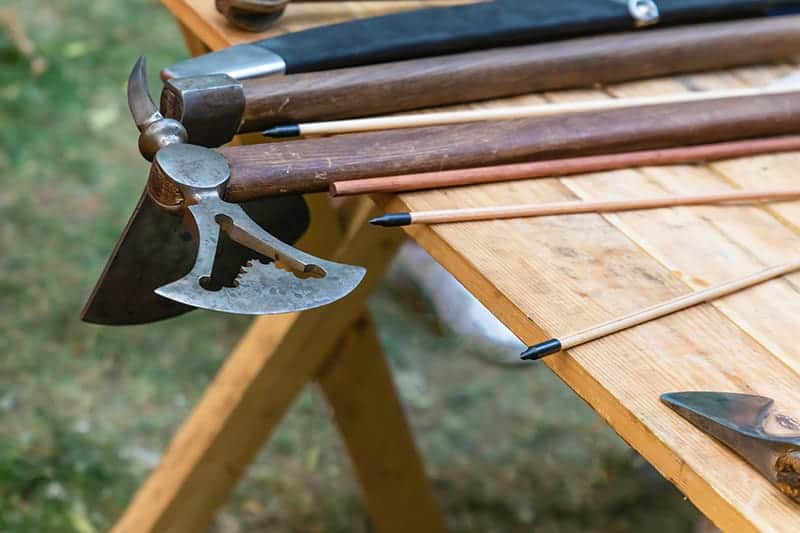Are you feeling confused about which type of axe to choose for your outdoor activity? Don’t worry, this article will provide a comprehensive guide to help you understand the different types of axes and make an informed decision.
With this knowledge, you can easily find the best axe for your specific needs and enjoy your outdoor adventure with peace of mind.
The axe is an essential tool used for a variety of outdoor activities such as camping and firewood collecting. From splitting logs to clearing branches and vegetation, the axe has been essential in providing us with the means to survive outdoors.
In this guide, we will explore the different types of axes available for outdoor activities, their uses, maintenance and safety tips. We will also explain how to pick the right type of axe for the job. So whether you are looking for a light-duty camp hatchet or something more robust like a felling axe – our guide has everything you need to know!

Explanation of outdoor activities
Outdoor activities involve participating in physical activities in natural environments such as forests, mountains, lakes, rivers and oceans. These activities range from low-level recreational activities to more vigorous workouts and involve the utilization of essential tools and resources that help participants maximize the potential for fun and excitement. One such tool is an axe, or hatchet, which is used for splitting wood, digging holes and clearing underbrush. It is important to have an understanding of the different axes available for outdoor activities in order to select the most compatible tool for your needs.
Understanding the type of activity one wishes to participate in will help determine the best axe for their use. Recreational camping often involves chopping firewood or preparing logs for a campfire and requires a basic hatchet or poleaxe. Hiking through woods or climbing mountains may require a more robust mountain axe with a larger head meant for splitting large logs or performing heavier tasks such as demolishing drywall. Likewise, using axes while participating in water-based outdoor activities often require smaller hand axes which make them more portable when carrying on boats or rafts. It is important to understand what type of activity you intend to take part in before selecting an axe to use outdoors in order to ensure safety and an enjoyable experience!
Importance of understanding different types of axes for outdoor activities
When it comes to tackling the great outdoors, you’ll always want to be equipped with the right tools. A trusty axe can come in handy for a multitude of activities such as chopping wood, clearing trails, hammering tent pegs and even cutting food. However, there are numerous types of axes available for different uses so it is important to understand the differences between them.
Axe shapes may vary between brands and models but all have three primary parts – a head (where most of the weight lies), a shaft (where your hand holds) and an end (usually metal). Generally speaking, axes are divided into two basic categories: hatchets and felling or splitting axes.
Hatchets are typically small sized axeheads with short handles best known for chopping kindling and building firewood shelters. On the other hand, felling or splitting axes are designed for larger-scale tree-cutting operations and are heavier than hatchets in order to power through a single clean cut stroke. It is also worth noting that there are specialized axes that combine some features from both these categories such as all-purpose outdoor survival tools or specialized woodsplitting wedges.
In order to get the most out of your outdoor endeavors, it is essential to know how each type of axe should be used as misuse can be dangerous both for you and your surroundings. While hatchets work best when making controlled swinging motions due to their short handles, felling/splitting axes require more forceful strokes since their longer handles allow them leverage on softer material like wooden logs found on campsites or lightly rooted vegetation like foliage near riversides. Furthermore, both of these tools should be sharpened regularly with a whetstone and honed regularly so they retain their edge between uses out in nature!
Features of Axes
Axes come in many different toppings, sizes, and styles in order to tackle multiple outdoor activities and tasks. Here is a list of common features you may come across when selecting an axe for your outdoor needs:
Head – The head of the axe is the business end, made up of the bit (the sharp edge) as well as the poll (the blunt back end). Depending on the task at hand, users have the option between a single or double-bit design. Axes that are used for chopping wood tend to have a broader blade with thicker metal and a duller poll than those intended for splitting wood or carving wood projects.
Handle – The handle can be either short or long depending on preference. Short handled axes are usually intended for light and accurate work such as carving logs while long handled axes provide more power and reach to split logs and clear out underbrush more efficiently. Choosing what length is best depends on how tall you are and what type of task you plan on completing.
Weight – The weight of an axe can vary tremendously depending on its size and design but it’s important to consider how much weight you feel comfortable lifting since it’s something that’s going to be heavily used during specific tasks. When searching for an axe consider trying different weights before making your final decision.
Grip – Quality handles will have enough grip for users to keep it firmly in place regardless of weather conditions like rain, snow or heat\cold weather. There are also aftermarket alternatives like wraps which allow you customize your handle providing improved security when using an axe outdoors.
Head
Axe heads are composed of a variety of metals and alloys, including steel, stainless steel, carbon steel and forged high-carbon steel. The type of metal used will vary depending on the intended use and the manufacturer’s style.
Steel is widely used for axe heads and comes in a variety of grades, including mild steel and stainless steel. Mild steels are the most popular option as they offer excellent strength while still being relatively lightweight. Many manufacturers use stainless steel for their axe heads to prevent corrosion from forming from exposure to water and other elements outdoors.
Carbon steel is a common choice for axe head manufacturing as it offers superior strength, toughness and wear resistance compared to milder grades or alloys. It can also take a much sharper edge than its softer counterparts for improved performance in outdoor activities. Forged high-carbon steels have been heat treated to improve durability even further but tend to be more expensive due to the additional processing involved.
Description
Axes are an essential part of outdoor activities such as camping, hunting, and woodcutting. These tools have a long history and come in many different shapes and sizes, each designed with different purposes in mind. Knowing which type of axe is best suited for your needs can be quite confusing.
In this guide, we will go over the different types of axes available and provide some insight into how they can be used to tackle a variety of tasks. We’ll also discuss what you should consider when purchasing an axe and offer some tips on caring for your tool to ensure it lasts you a lifetime.
Blade
Blade axes are ideal for activities like hatchet throwing, cutting modest-sized logs and branches, carving, making kindling and other outdoor activities requiring precision. Blade axes have smaller heads than felling axes, weighing in at one to four pounds. Depending on the size and weight of the head, blade axes may or may not require two hands to wield. The main difference between a blade axe and other types of axes is its head’s curved or flat blade shape that resembles a knife or a sickle. Because of this high-precision design, it’s no wonder why blade axes are some of the favorite tools among woodcarvers who use them for intricate cuts.
Early humans used handaxes made out of stone for cutting wood, hunting small mammals, and as defensive weapons; which were then replaced by bronze and iron blades over time. The most notable feature about blade or hatchet marking is its lipped choils which reinforce the area where users place their middle finger when controlling precision shots with the tool; providing maximum edge strength and longevity even with heavy wear and tear.
Description
Axes are essential tools for many outdoor activities such as camping, hiking, and home maintenance. Whether you’re splitting firewood for a cozy campsite or trimming away excess branches from your backyard, having the right axe can make the job much easier. But with so many different types of axes available, it can be hard to know which one is best suited for your needs.
In this guide we will explore the different types of axes available and how to choose the one that is right for you.

Handle
The handle is the end of an axe opposite the head, and it provides a comfortable grip for your hand. It’s typically made from a solid hickory or ash shaft, which is renowned for its strength and durability.
The handle should be securely attached to the axe head, with rivets, glues or a combination of both holding them together. When choosing an axe handle, pay attention to its shape and length; many handles are shaped so that they’re easier to hold, while the length will determine how much power you can put into each chop.
You should always inspect the handle before committing to buying an axe; look for weak spots or signs of damage.
Description
What is an Axe? An axe is a tool primarily used for cutting, splitting or chopping wood. It consists of a sharpened metal head mounted on usually by two handles called helves. It has been used throughout history to harvest timber and cut firewood, as well as for long-distance transportation of logs.
Axe shapes differ depending on their intended purpose, such as felling trees, splitting large logs into chunks, cutting down saplings or branches, carving projects and more. Traditional axes are also an indispensable tool when camping and hiking in the wilderness. Modern axes come in a variety of sizes and shapes designed to meet different needs for different tasks in the great outdoors.
When purchasing an axe for your outdoor activities, it’s important to keep in mind the two main elements that characterize each type—the weight of the head and the shape of the bit. Both will determine how effective your axe will be at its intended task:
Conclusion
To sum up, a complete understanding of axes helps you to determine the right type of axe for your specific needs. Different activities require different axes with features suitable for the purpose. There are various types of axes available suited to different needs, such as chopping and splitting wood, digging and digging roots, felling trees and more.
Additonally, you should be sure to take the time to select an axe with the correct shape for the action you plan on doing. A safe use and correct maintenance are also important aspects that could extend the lifespan of your axe.
With adequate knowledge on selecting, using and caring for your axe properly, you can ensure that it will serve its permitted purpose optimally.
FAQs
What is the difference between types of axes?
The different types of axes vary in their size, shape, weight, and purpose, which determines their effectiveness for different tasks.
What are the 9 types of axes?
The 9 types of axes are: felling axe, splitting maul, carpenter’s axe, broad axe, hatchet, hand axe, adze, gutter adze, and bowl adze.
How many types of axes are there?
There are many types of axes, but the most common types are felling axes, splitting mauls, hatchets, and carpenter’s axes.
What are things axes are used for?
Axes are commonly used for tasks such as chopping firewood, felling trees, splitting logs, shaping wood, and building structures.
What are characteristics of axes?
Some common characteristics of axes include a sharp blade made of metal, a handle made of wood or composite materials, and a weight that is balanced for efficient use.
What type of axe is best for cutting down trees?
A felling axe is typically the best type of axe for cutting down trees due to its long handle, heavy head, and sharp blade.
What type of axe is best for survival?
A hatchet is often considered the best type of axe for survival due to its portability, versatility, and usefulness in a wide range of tasks.
How do I choose an axe?
When choosing an axe, consider factors such as the intended use, the size and weight of the axe, the handle material, and the quality of the blade.
Which axe is used to cut sugarcane?
A machete is commonly used to cut sugarcane due to its long, curved blade and ability to make quick and precise cuts.
What axe is best in forest?
A felling axe or a hatchet can both be useful in a forest, depending on the specific task at hand.
See more-
- Best axe for chopping wood 2023
- Best axe sharpener 2023
- Best throwing axe 2023
- Best felling axe 2023
- Best axe for cutting down trees 2023


